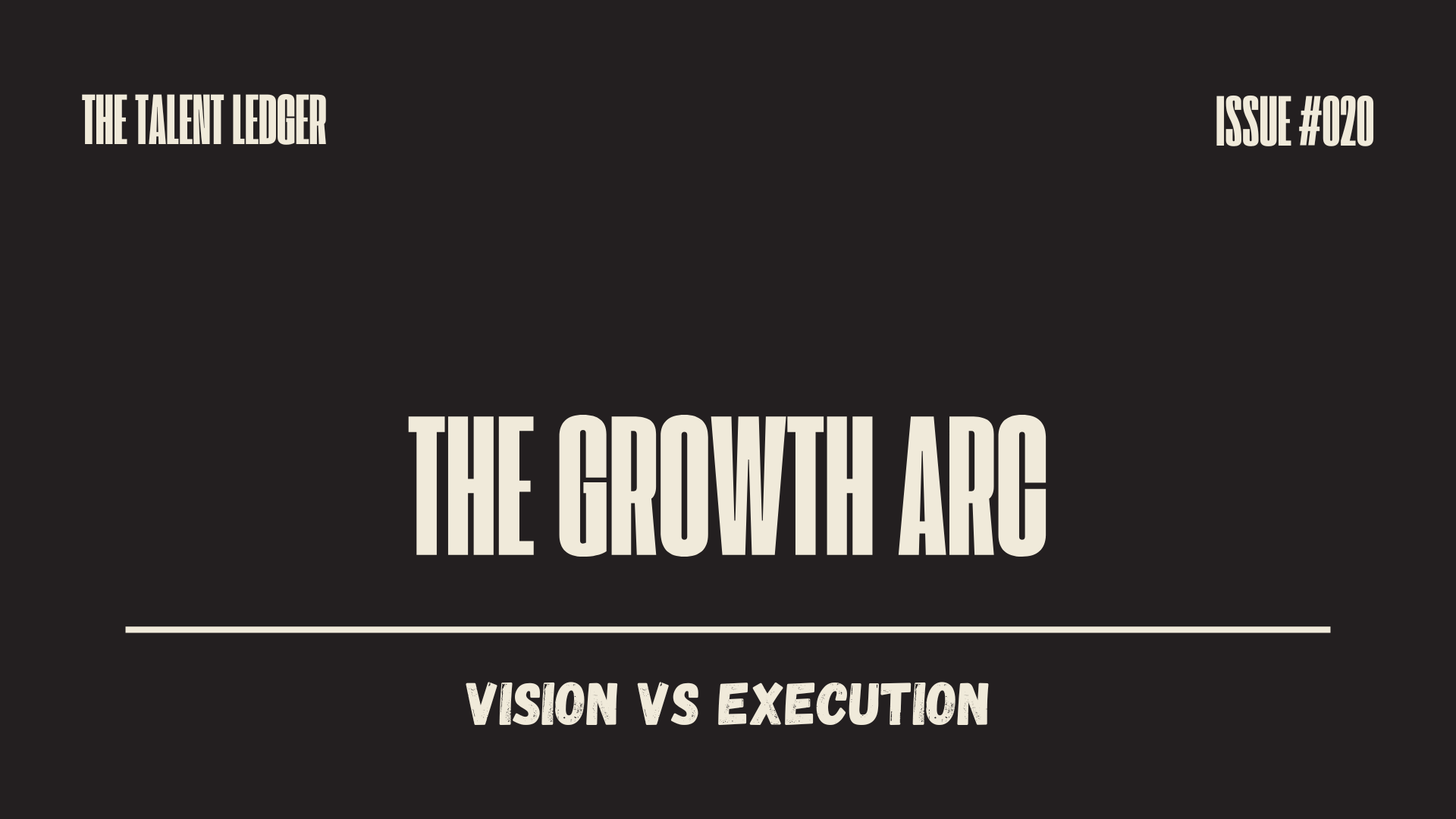- The Talent Ledger
- Posts
- The Growth Arc
The Growth Arc
How founders evolve from vision to execution over time


𝐖𝐞𝐞𝐤𝐥𝐲 𝐓𝐚𝐤𝐞
Most founder assessments happen in a snapshot - one meeting, one deck, one decision. But the real insights emerge over time, as initial vision meets market reality.
This week, I'm taking a different approach. Instead of comparing two founders, I'm examining one founder's journey from initial investment to now - 30 months later. The changes show how the best founders don't just stick to their vision; they get better at everything around it.
This progression from concept to working business shows why betting on founder growth often matters more than betting on founder perfection.
𝐅𝐨𝐮𝐧𝐝𝐞𝐫 𝐏𝐫𝐨𝐟𝐢𝐥𝐞
Founder A |
|---|
📅 Age: 50’s |
📍 Geography: Southwest |
📈 Stage: Pre-revenue with early LOIs and prototypes |
⚡ Industry: AI-driven industrial automation |
🎓 Background: Long career in industrial software sector |
🔥 X-Factor: Compelling vision paired with decades of experience solving the exact problem in the exact industry |
𝐓𝐡𝐞 𝐄𝐯𝐨𝐥𝐮𝐭𝐢𝐨𝐧
𝐓𝐡𝐞𝐧: 𝐕𝐢𝐬𝐢𝐨𝐧 𝐖𝐢𝐭𝐡𝐨𝐮𝐭 𝐕𝐚𝐥𝐢𝐝𝐚𝐭𝐢𝐨𝐧 ⏮️
This founder's AI automation platform targeted outdated industrial systems across energy, utilities, and infrastructure. The premise made sense - modernizing old workflows with better control and optimization.
Their industry background opened doors fast. Years in industrial software created credibility and the right network for initial conversations. The market need was clear, and his positioning worked.
However, the initial pitch was heavy on vision and light on proof. The deck had the right buzzwords - AI, predictive control, real-time optimization - but lacked clarity on how it actually worked and how he'd sell it.
Early progress was slow. Pilots took longer than expected. Customers were interested but hesitant to commit. It felt like a concept looking for concrete application rather than a proven solution to validated problems.
There was substance there, but it hadn't yet turned into measurable results.
𝐍𝐨𝐰: 𝐄𝐱𝐞𝐜𝐮𝐭𝐢𝐨𝐧 𝐌𝐞𝐞𝐭𝐬 𝐄𝐯𝐨𝐥𝐮𝐭𝐢𝐨𝐧 ⏭️
Thirty months later, the same founder runs a different company. The vision is the same, but everything around it has gotten stronger.
The team changes were smart. They brought in operational experts and domain specialists who matched his industry knowledge with execution ability. These weren't just hires - they were strategic additions that sped up both technical delivery and sales progress.
The messaging evolved from abstract to concrete. Instead of broad AI claims, the focus shifted to specific outcomes: measurable downtime reduction, proven remote optimization, and clear data visibility improvements. The value became tangible rather than theoretical.
Sales validation followed clearer messaging. Early pilots that had stalled began converting to contracts. Use cases became repeatable. The implementation process got more predictable, and customer success stories emerged.
His persistence through the slow early period paid off. Rather than changing direction when things got hard, they kept refining both product and pitch until market fit emerged. Same vision, executed with more precision and supported by better capabilities.
𝐌𝐲 𝐑𝐮𝐛𝐫𝐢𝐤
𝐀 𝐯𝐢𝐬𝐮𝐚𝐥 𝐛𝐫𝐞𝐚𝐤𝐝𝐨𝐰𝐧 𝐨𝐟 𝐤𝐞𝐲 𝐟𝐚𝐜𝐭𝐨𝐫𝐬 𝐢𝐧 𝐦𝐲 𝐢𝐧𝐯𝐞𝐬𝐭𝐦𝐞𝐧𝐭 𝐝𝐞𝐜𝐢𝐬𝐢𝐨𝐧

This progression shows how execution capabilities improve over time through experience and smart team building.
𝐄𝐧𝐠𝐚𝐠𝐞𝐦𝐞𝐧𝐭 𝐂𝐨𝐫𝐧𝐞𝐫
𝐐: 𝐇𝐨𝐰 𝐝𝐨 𝐟𝐨𝐮𝐧𝐝𝐞𝐫𝐬 𝐞𝐯𝐨𝐥𝐯𝐞 𝐟𝐫𝐨𝐦 𝐯𝐢𝐬𝐢𝐨𝐧 𝐭𝐨 𝐞𝐱𝐞𝐜𝐮𝐭𝐢𝐨𝐧?
This founder didn't change his core idea - he just stopped talking in circles about it. His early pitch was full of AI this, optimization that. His current pitch shows specific customers saving specific amounts of money on specific problems.
The difference wasn't strategy. It was surrounding himself with people who knew how to ship product and close deals. He hired his weaknesses instead of pretending they didn't exist.
Most founders I see keep iterating on their pitch deck instead of iterating on their business. They think better slides equal better results. This founder spent those 30 months building actual capabilities while his competitors were still perfecting their demo.
The transformation isn't sudden. It's just invisible until it's not.
𝐒𝐡𝐚𝐫𝐞 𝐓𝐡𝐞 𝐓𝐚𝐥𝐞𝐧𝐭 𝐋𝐞𝐝𝐠𝐞𝐫
Refer a founder → Get direct access to Will for strategic advice.
Get unfiltered advice on overcoming founder challenges
Ask about investment reality and what's actually working
Dive deeper into any Talent Ledger topic that resonated with you

You currently have 0 referrals, only 1 away from receiving a 15-Minute Strategy Session with Will Stringer.
Or copy & paste this link.
𝐂𝐥𝐨𝐬𝐢𝐧𝐠 𝐓𝐡𝐨𝐮𝐠𝐡𝐭𝐬
Every early-stage company starts with ambition, but durable founders are defined by what happens after the first deck. Do they refine the story or stay stuck in the vision? Do they bring in talent or try to carry everything solo? Do they keep pressing when pilots drag and customers hesitate?
This founder didn't just survive the slow start - he used it to build something stronger. Most founders think investors back vision, but we actually back people who can turn vision into revenue. The ability to evolve from good idea to good business separates the companies that scale from those that stagnate.
Vision gets you in the room. Execution gets you the check. Evolution gets you the second check.
The ledger entry is clear: bet on founders who understand that the pitch is just the beginning, not the destination.
Auditing more talent next week,
Will Stringer

𝐅𝐞𝐞𝐝𝐛𝐚𝐜𝐤
Did you enjoy this issue?Your feedback will be used to refine this newsletter. |
P.S. If you found value in this entry, add it to someone else's ledger by forwarding this email. If you're that someone, subscribe here to get inside access to how I invest in exceptional people.